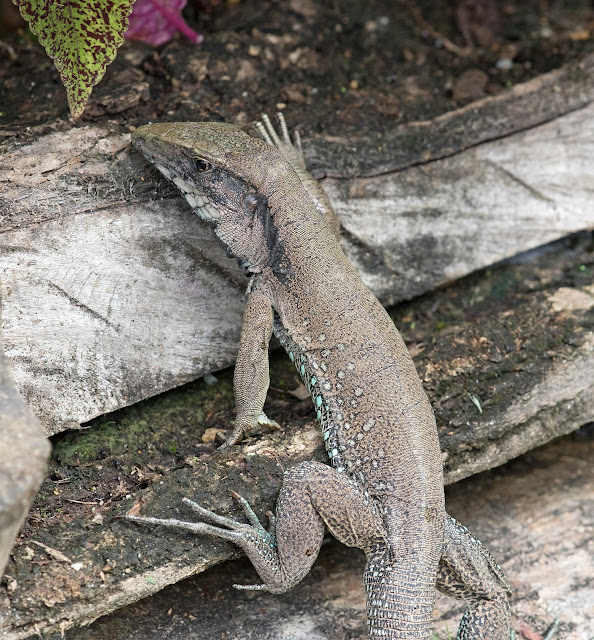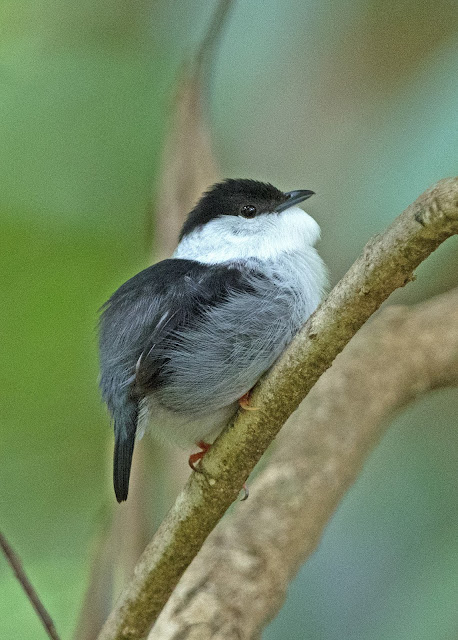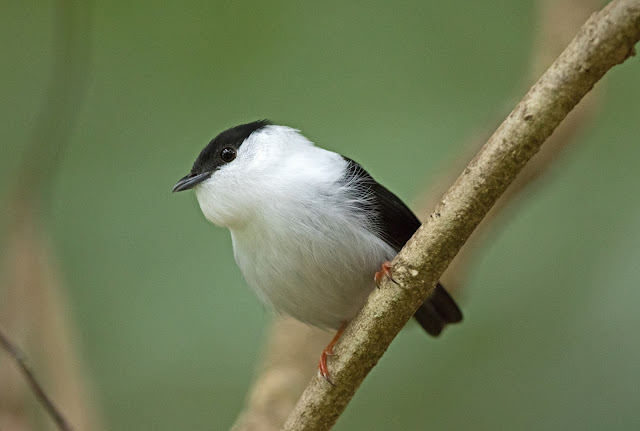Today was a go slow sort of morning and early afternoon where the order of the day was to chase a few birds to improve the photographs. Post tea we set off for some night birding at Wallerfield, a disused US airfield that has become home to some great birds. All of which resulted in a great tick list but far fewer photographs than on previous days.
I didn't make the crack of dawn start on the veranda but had a pre-breakfast stroll in the immediate vicinity of the centre. The Cocoa Thrush was in its usual position beneath the veranda and we exchanged pleasantries.
 |
| Cocoa Thrush |
 |
| Cocoa Thrush |
Post breakfast most of the group joined up for a scout round the Motmot trail as several Trinidad Motmots had been reported. Unfortunately we didn't catch up with one but I did manage to see some roosting Proboscis Bats, a friendly Great Kiskadee and a rather distant Tropical Peewee.
 |
| The regular Great Kiskadee - this one ringed |
 |
| Tropical Peewee |
During the morning I met up with one of the group and we set off for the Golden-Headed Manakin lek,. When we arrived there was no obvious presence but a couple of other birders had seen one earlier. We both put into practice our best "pishing" calls and mimicry of a Ferruginous Pygmy Owl. Miraculously two Manakins put in an appearance, of sufficient duration to get one decent shot before they bolted back down the hill. They had been fooled once but they definitely weren't coming close again, happy to dance up and down on a twig, almost out of sight.
 |
| Definitely a lek - but at some distance. |
 |
| They came close just for a few brief moments. |
No matter where I go birding, I always find an activity where I can spend endless amounts of time and an infinite number of pixels trying to capture a ridiculously hard subject. I set up shop just down from my cottage door and waited for the Tufted Coquettes to come. Oddly enough the majority I managed to capture were females - just that bit more obliging.
During a coffee break a Common Black Hawk paid a visit - albeit at a distance.
 |
| Common Black Hawk |
 |
| Tegu with a complete tail |
 |
| White-necked Jacobin (f) |
Butterfly numbers were going up, I managed to capture Iphiclus Sister, Cloudless Sulphur and Cassius, the rest just flew by at high speed. The Postman was most disappointing as I couldn't manage to recreate the true red of a very bright butterfly. Just like the Red Admirals at home the red in the camera is not the same as the red seen by the eye.
 |
| Iphiclus Sister |
 |
| Cassius |
 |
| Cassius |
 |
| Cloudless Sulphur |
 |
| Ermmm??? |
 |
| The Postman |
On the way to Wallerfield I manage a couple of shots of a Turkey Vulture sat in a tree close to the road.
When we arrived at Wallerfield the light was fading fast but Dave managed to find two rarities in the stand of Moriche Palms. First up was a Sulphury Flycatcher which I managed to record as a yellowy blob high up in the canopy. The Moriche Oriole was a bit more of a success, at least you can see what it is. As we had dinner amid the gathering gloom we were entertained by a Mottled Owl which flew back and forth across the road. As the light vanished we had a calling Pauraque and it was picked up in the lights. Although I had bought a pretty hefty flash gun it was obvious that having the camera out was pointless. So I just enjoyed the night birding experience. Unfortunately another group had spooked the Common Potoo so we dipped a bird that was fairly high on the wanted list.
Finally as we made it back to base, outside the cottage door was a large moth just asking to be photographed and I duly obliged.
 |
| ID - ongoing! |









































































